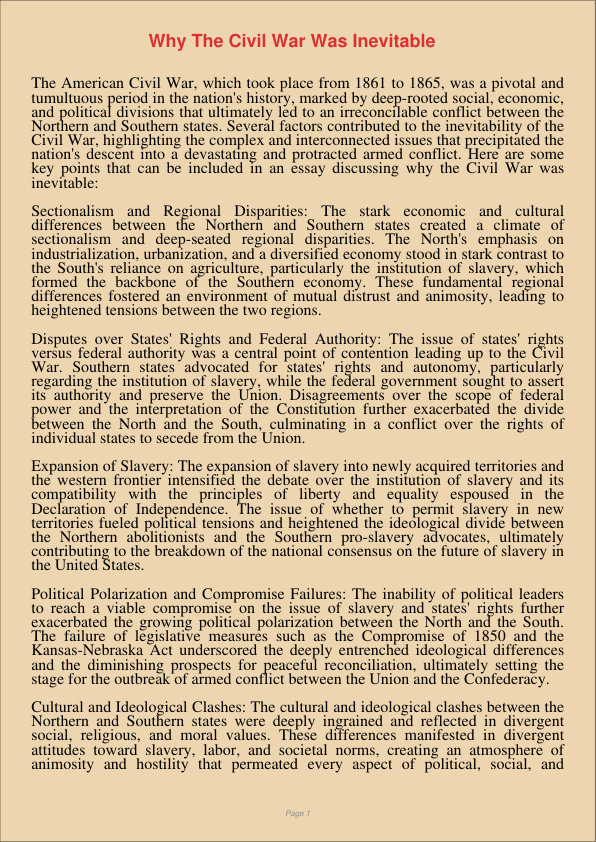Why The Civil War Was Inevitable
Dec 31, 2023
civil war
inevitable
Gender & Sexual Studies
Other
The American Civil War, which took place from 1861 to 1865, was a pivotal and tumultuous period in the nation’s history, marked by deep-rooted social, economic, and political divisions that ultimately led to an irreconcilable conflict between the Northern and Southern states. Several factors contributed to the inevitability of the Civil War, highlighting the complex and interconnected issues that precipitated the nation’s descent into a devastating and protracted armed conflict. Here are some key points that can be included in an essay discussing why the Civil War was inevitable:
Sectionalism and Regional Disparities: The stark economic and cultural differences between the Northern and Southern states created a climate of sectionalism and deep-seated regional disparities. The North’s emphasis on industrialization, urbanization, and a diversified economy stood in stark contrast to the South’s reliance on agriculture, particularly the institution of slavery, which formed the backbone of the Southern economy. These fundamental regional differences fostered an environment of mutual distrust and animosity, leading to heightened tensions between the two regions.
Disputes over States’ Rights and Federal Authority: The issue of states’ rights versus federal authority was a central point of contention leading up to the Civil War. Southern states advocated for states’ rights and autonomy, particularly regarding the institution of slavery, while the federal government sought to assert its authority and preserve the Union. Disagreements over the scope of federal power and the interpretation of the Constitution further exacerbated the divide between the North and the South, culminating in a conflict over the rights of individual states to secede from the Union.
Expansion of Slavery: The expansion of slavery into newly acquired territories and the western frontier intensified the debate over the institution of slavery and its compatibility with the principles of liberty and equality espoused in the Declaration of Independence. The issue of whether to permit slavery in new territories fueled political tensions and heightened the ideological divide between the Northern abolitionists and the Southern pro-slavery advocates, ultimately contributing to the breakdown of the national consensus on the future of slavery in the United States.
Political Polarization and Compromise Failures: The inability of political leaders to reach a viable compromise on the issue of slavery and states’ rights further exacerbated the growing political polarization between the North and the South. The failure of legislative measures such as the Compromise of 1850 and the Kansas-Nebraska Act underscored the deeply entrenched ideological differences and the diminishing prospects for peaceful reconciliation, ultimately setting the stage for the outbreak of armed conflict between the Union and the Confederacy.
Cultural and Ideological Clashes: The cultural and ideological clashes between the Northern and Southern states were deeply ingrained and reflected in divergent social, religious, and moral values. These differences manifested in divergent attitudes toward slavery, labor, and societal norms, creating an atmosphere of animosity and hostility that permeated every aspect of political, social, and economic life in antebellum America.
In conclusion, the American Civil War was the culmination of a series of interconnected factors that contributed to the inevitability of a violent and protracted conflict between the Northern and Southern states. The deep-rooted issues of sectionalism, states’ rights, slavery, and political polarization underscored the profound societal and ideological divisions that ultimately led to the fracturing of the Union and the deadliest armed conflict in American history.
